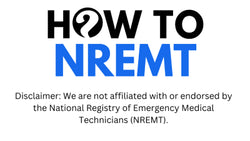Imagine confidently facing the NREMT cognitive exam—every question, every scenario under control. That’s exactly what the 2025 exam format expects from you. This isn’t just a new test; it’s a new kind of thinking. The days of memorizing definitions and guessing your way through are long gone.
Now, clinical scenarios take center stage. Technology Enhanced Items (TEIs) challenge how you analyze, sort, and respond under pressure. If you walk in unprepared for the format itself, not just the content, you’re taking a massive risk.
The good news? You can get ready for this with the right plan. To pre pare for the NREMT exam in 2025, you’ll need more than flashcards and quizzes. You’ll need focused practice, real clinical logic, and tools built around how today’s test actually works.
We’ll break it all down here, from TEI strategy to smart study schedules, to help you go in clear, confident, and ready to pass.
1. Understand the New Format
The NREMT cognitive exam has been transformed:
·Five updated domains now mirror real-world thinking
·Technology Enhanced Items (TEIs), drag-and-drop, list-building, are baked in
·Standard multiple-choice remains, but integrates judgment over recall
That means you can’t rely on old study habits. You need scenario-driven thinking built on building blocks.
2. Map Your Study Strategy to Domains
A strong study plan aligns with both content and thinking skills. Here’s a table to help:
|
Domain |
Key Focus Area |
|
Scene Size-Up & Safety |
Hazard recognition, body mechanics, scene control |
|
Primary Assessment |
Rapid identification of life threats |
|
Secondary Assessment |
Systematic patient data gathering |
|
Patient Treatment & Transport |
Decision-making, interventions, safe transport |
|
Operations |
Communication, documentation, situational logic |
From day one, structure review sessions by domain. Then add TEI drills to build speed and accuracy in real scenarios.
3. Master Technology Enhanced Items (TEIs)
TEIs are the game-changer. They look like:
1. List-building: arranging airway steps
2. Drag-and-drop: sorting meds by route
3. Checkbox tables: classifying chest assessments
Tactical Tips:
·Dedicate daily drills: 15 minutes of TEIs per domain
·Analyze each interaction—why choices are correct or incorrect
·Create your own TEI-style practice items after each study session
Habitual TEI practice is the best way to study for NREMT.

4. Use CAT Simulations to Build Test Endurance
The NREMT cognitive exam isn’t your typical multiple-choice test. It’s a Computer Adaptive Test (CAT), which means every answer you give determines the next question you get. The better you do, the more complex the test becomes. It adjusts in real time to challenge your clinical reasoning and decision-making.
That’s why CAT simulations aren’t optional anymore; they’re essential.
Practicing with CAT-style exams isn’t just about “getting used to the test.” It’s about training your brain to stay sharp when the pressure increases. You need to stay focused for up to two hours, process long clinical scenarios, and make confident decisions under time limits. That kind of endurance only comes with regular simulation.
Simulations also help you develop key testing skills:
·Reading stamina: You’ll be presented with long questions and complex wording. Sim practice helps you stay mentally clear through the entire session.
·Stress control: When you face tougher items, your anxiety might spike. Simulations help you stay calm and focused—even when the difficulty rises.
·Decision speed: CAT exams aren’t just hard—they’re fast. You don’t want to freeze when you hit an unfamiliar TEI or case-based item.
The best strategy? Mix up your practice.
|
Simulation Type |
What It Builds |
|
Full-length CAT |
Builds stamina, pacing, and mental focus |
|
Domain-specific blocks |
Deepens targeted knowledge without burnout |
|
Timed TEI sets |
Hones your quick thinking under pressure |
We recommend doing at least one full-length CAT simulation per week during your prep phase. Treat it like the real exam: no breaks, no skipping questions, no guessing early. Track your performance trends across each domain, especially where you consistently slow down or struggle.
Then, rotate in shorter, focused drills during the week. Use domain-specific blocks (e.g., 20–30 questions just on Primary Assessment or Patient Treatment and Transport) to boost weak spots. And don’t skip the TEI sets. TEIs like drag-and-drop, build-list, and checkbox questions now appear regularly, and they test a completely different skill set than standard multiple choice.
Bottom line: CAT performance is a muscle, and like any muscle, it needs consistent resistance to grow stronger. The more often you simulate test conditions, the more natural they’ll feel on exam day. You won’t just survive the adaptive format; you’ll master it.

5. Blend Conceptual Review with Practical Scenarios
Facts matter, but context matters more. Mix in:
·Clinical case studies: pediatric respiratory distress, trauma calls
·Skill-based flashcards: airway protocol, cardiac algorithms
·Reflection sessions: break scenarios into what you’d do, how, and why
This combination solidifies both knowledge and judgment under pressure.
6. Supplement with Guided Prep Classes
A live NREMT prep course creates structure you can’t replicate alone:
Regular instruction with experienced educators
Live Q&A and real-time feedback
Peer comparison to measure your benchmarks
It’s not just content—it’s community accountability and momentum. Join our 7 or 14-day EMT boot camp classes held online and prepare for the upcoming test for a quick refresher.
7. Use Personalized EMT Tutoring When Struggling
Tutoring is your secret weapon. It helps when:
You're plateauing at ~75% on mocks
You've repeatedly struggled with TEIs
You need focus on specific domains like Operations
A focused tutor session helps break through uncertainty into clarity.
8. Build an Adaptable Study Schedule
Your weekly model might look like:
|
Day |
Task |
|
Mon |
Domain review + TEI drills |
|
Tue |
CAT simulation |
|
Wed |
Scenario flashcards + review |
|
Thu |
TEI focused session |
|
Fri |
Small quiz + tutor/peer review |
|
Sat |
Full CAT + pacing analysis |
|
Sun |
Light review + reflection |
Adapt as you improve, but keep consistency and variety.

9. Mentally Prepare for TEIs and Concepts
Getting ready for the NREMT cognitive exam isn’t just about mastering facts; it’s also about controlling your headspace. Many candidates know the material but freeze up when it matters most. That’s why mental preparation needs to be part of your study strategy.
The Technology-Enhanced Items (TEIs), like build-list, drag-and-drop, and checkbox questions, look unfamiliar at first, and when your brain perceives something unfamiliar, it can panic. That’s normal. The solution? Take the fear out of it through low-stress exposure.
Start by practicing TEIs in a no-pressure setting. Don’t time yourself yet. Just get used to how the questions look and what they’re asking you to do. This simple step rewires your stress response from “what is this?” to “I’ve done this before.”
Before timed sessions, practice calming techniques. Deep breathing. Body scanning. Positive framing. Even a 30-second pause before launching a study block can make a difference.
Also, keep a running mistake log. Write down what you got wrong and why. Look for patterns like do you rush clinical judgment questions? Misread checkbox instructions? Not only will this help you improve, but it trains you to see mistakes as part of the process, not as failure.
Finally, simulate high-stakes test days. Set up exam-like conditions and sit through TEIs as if it’s the real thing. That experience builds real confidence; not from hoping you’ll pass, but from knowing you’re ready.
10. Final Week Tactics: Fine-Tuning Focus
The last week before your NREMT cognitive exam is not the time to cram. It’s about strategy, focus, and protecting your mental stamina. Here's how we recommend structuring your final days:
• Shift to review over new content
Now is not the time to introduce new chapters or tools. Instead, revisit your most-missed topics, incorrect answers, and concepts you flagged earlier. Focus on tightening what you already know. This builds confidence and helps solidify memory without adding mental clutter.
• Revisit tough TEI types
If drag-and-drop or build-list questions still throw you off, don’t avoid them—practice them daily. Go slowly. Re-read instructions. Make sure you understand what’s being asked before answering. Repetition with feedback is key to making these formats second nature.
• Run one full CAT mid-week, one two days before test
Use a high-quality NREMT cognitive exam practice that mimics real CAT conditions. Sit through the full timing. Take it seriously. Then analyze your results. Your final CAT (Computer Adaptive Test) attempt should be two days before your test, giving your brain recovery time while keeping skills sharp.
• Final day: light review, rest, prep materials
No hard studying on the last day. Skim your notes. Review any last-minute reminders. Charge your ID-verified device or print your test authorization email. Go to bed early. Don’t overlook hydration, meals, and movement. A calm, rested brain performs far better than a tired one.

11. On Test Day: Tactical Success
Before entering:
• Eat lightly, hydrate
• Use breathing to reset nerves
• Survey the TEI tutorial fully
• Keep calm with small pacing and break awareness
Treat it like a shift—you’ve prepared for this moment.
The modern NREMT cognitive exam demands more than memorization. It demands clinical intelligence, adaptive thinking, and calm under pressure. If you prepare for the NREMT exam using structured drills, simulation, and guided support, you’ll face the new format ready—and walk out knowing you got this.
Your Path to Exam Success: Join How To NREMT—Your Best Test Prep Partner
We’ve built our NREMT prep course to match every 2025 requirement: TEIs, clinical skill drills, CAT simulations, and emotional readiness training. Ready to pass with confidence? Join us today to access live instruction, expert tutors, and full-format simulations.

